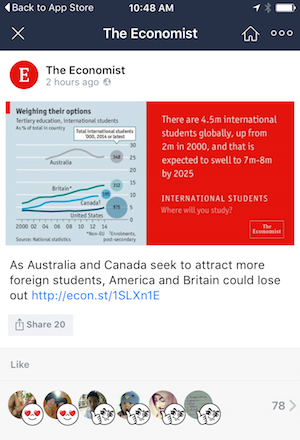
Love our charts? They are now available in instant messages https://t.co/WoWtg8O5Cg pic.twitter.com/bKZNxM6muy
— The Economist (@ECONdailycharts) January 27, 2016
“Clearly messaging apps are where social media is going next, and we and other publishers need to figure them out,” Tom Standage, deputy editor of The Economist, told me.
 Why choose the Japan-based Line over a more globally popular messaging app like WhatsApp or Facebook Messenger? Standage said that the app’s audience is “complementary” to The Economist’s existing Facebook and Twitter audiences. It also supports both bots and conversational interfaces, “which is something we plan to experiment with this year,” he said. “Obviously there will be more support for publishers on Messenger and WhatsApp in the future, but Line is further along in that regard, which means we can get started now.”
Why choose the Japan-based Line over a more globally popular messaging app like WhatsApp or Facebook Messenger? Standage said that the app’s audience is “complementary” to The Economist’s existing Facebook and Twitter audiences. It also supports both bots and conversational interfaces, “which is something we plan to experiment with this year,” he said. “Obviously there will be more support for publishers on Messenger and WhatsApp in the future, but Line is further along in that regard, which means we can get started now.”
Line had 215 million monthly active users as of the end of 2015, with 67 percent of those coming from Japan, Taiwan, Thailand, and Indonesia. (The Facebook-owned WhatsApp, meanwhile, has nearly a billion monthly active users.) But Line is unique among messaging apps in that it pulls in a lot of revenue from sales of stickers, books, games, and ads — it pulled in ¥120.7 billion (US$1.02 billion) in revenue in 2015.
The company has also expanded into news and media in Asia. From its 2015 year-end earnings report:
LINE NEWS, a news distribution service available in Japan, has successfully launched the “LINE Account Media Platform,” a new service which allows external media outlets to distribute news by creating an Official Account. LINE NEWS topped 22 million monthly active users in December 2015. LINE LIVE, a new live streaming platform that provides live video and programming free of charge, launched on December 10, 2015 and received more than 11 million unique viewers in its first month. Both of these services are exhibiting strong growth immediately after their respective launches. Meanwhile, the video-on-demand service LINE TV available in Taiwan and Thailand is steadily increasing users by offering more and more dramas and variety programs that suit the tastes of the respective regions.
Other English-language news outlets — including The Wall Street Journal, BuzzFeed, the BBC, TechCrunch, and Mashable — are also on Line.
In addition to charts, The Economist will also experiment with posting photos of the day, quotes, and video to its Line account. Line provided clear directions on which aspect ratio is optimal for push messages and its homepage, said Denise Law, The Economist’s deputy community editor, “so we worked with our designers to build templates that would enable us to promote charts more effectively.”
For now, The Economist plans to publish 4 to 6 pieces per day to its Line homepage, and to send two or three push notifications per week, said Law, “including a preview of our cover, breaking news blogs, explainers, and articles from our [morning briefing] Espresso.”“We expect to be able to apply what we learn from publishing on Line to other platforms,” Standage said. “Telegram seems like a particularly good platform on which to experiment with bots, and Snapchat is coming up the field fast. The challenge for us, and for other publishers, is not just to figure out what works best on each platform, but also to decide which platforms to focus on and how to allocate our resources between them.”